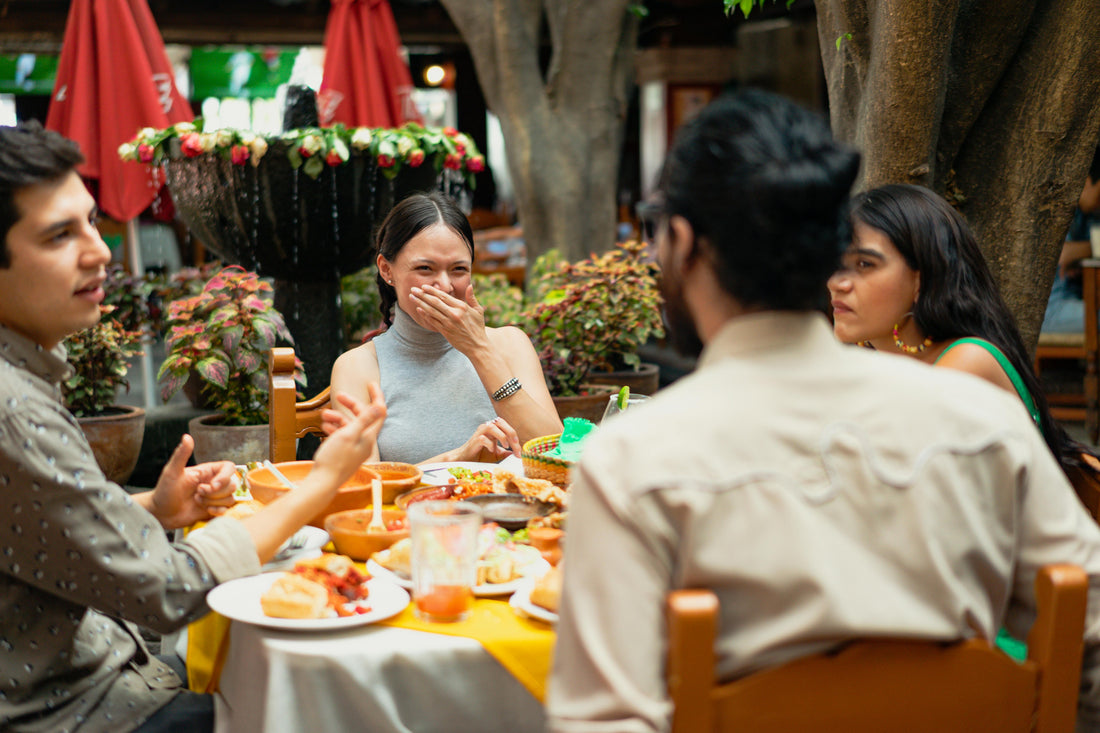
Mexican Spanish Slang: 20 Essential Expressions You Won’t Learn in School
Share
Why You Need to Learn the Real Language of the Streets
When learning a language, textbooks usually focus on grammar, polite conversation, and “neutral” vocabulary. But if you want to connect with locals in Mexico, navigate everyday conversations, or even just understand the jokes and memes, mastering Mexican slang is non-negotiable. These expressions reflect culture, attitude, and identity.
And while courses and dictionaries are great, they often skip the most colorful—and most used—phrases. That’s why immersing yourself in real dialogue is so powerful. One of the best ways to do that is through storytelling. If you’re looking to deepen your vocabulary while enjoying engaging narratives, Short Stories in Mexican Spanish is a great tool. It blends authentic language with context, helping you absorb slang and colloquial speech in a natural, entertaining way.

Mexican Slang vs. Standard Spanish
Before diving into expressions, let’s clarify something: Mexican slang is deeply regional. While many of these phrases are understood throughout the country, others might be more common in specific cities or age groups. It’s informal, and often tied to humor, sarcasm, or street culture.
You’ll find that Mexican Spanish often reinvents the meaning of ordinary words. So let’s explore 20 expressions you won’t hear in your Spanish class—but will definitely hear on your next trip to Mexico.
1. ¿Qué onda?
A casual way to say “What’s up?” or “How’s it going?”, ¿Qué onda? literally translates to “What wave?” But in context, it’s all about asking how someone is or greeting a friend. It’s equivalent to “What’s the vibe?” and is often used between young people or close acquaintances.
Examples:
- ¡Qué onda, güey! ¿Todo bien?
- Vamos al cine, ¿qué onda?
“Onda” can also refer to someone’s style or energy. Tiene buena onda means “They have good vibes.”
2. No manches
No manches is one of the most versatile expressions in Mexican slang. It can mean “No way!”, “You’re kidding!”, or even “Stop messing around!” Depending on the tone, it can express surprise, disbelief, or annoyance.
It comes from “manchar” (to stain), but this is purely idiomatic.
Examples:
- ¿Ganaste la lotería? ¡No manches!
- No manches, llegaste tardísimo.
It’s the polite cousin of a stronger version: no mames, which is much more vulgar.
3. ¡Órale!
This one’s a true Mexican classic. Depending on how you say it, ¡Órale! can mean:
- “Wow!”
- “Let’s go!”
- “Right on!”
It comes from the verb “orar” (to pray), but that connection is long gone. Use it to show surprise, agreement, or enthusiasm.
Examples:
- Órale, qué chido tu coche.
- ¿Ya nos vamos? ¡Órale!
4. Chido / Chida
Another essential in Mexican slang, chido means “cool”, “awesome”, or “great”. It can describe a person, object, or experience.
Examples:
- Está bien chido ese lugar.
- Tu hermano es chido, me cayó bien.
You might also hear padre used in a similar way (see expression #8).
5. Güey (or wey)
Possibly the most used and most confusing word in Mexican Spanish: güey. It originally meant “ox”, as in a slow or dumb animal, but now it’s used casually like “dude” or “man”. It can be friendly or insulting—context is everything.
Examples:
- ¿Qué onda, güey?
- No seas güey, eso es peligroso.
It’s often shortened to just “wey” in text or informal speech.
6. Neta
Neta literally means “the truth”, but in Mexican slang it’s used to emphasize honesty or sincerity. It can mean “Really?”, “No kidding”, or “Seriously”.
Examples:
- ¿Neta te vas a ir sin despedirte?
- Te lo digo neta, está buenísima esa serie.
Used on its own: ¿Neta? = “For real?”
7. Aguas
This may sound like it means “waters”, but in Mexican slang, ¡Aguas! is a warning—like “Watch out!” or “Heads up!”. It likely comes from colonial times when people dumped dirty water into the streets yelling “¡Aguas!”.
Examples:
- ¡Aguas! Se te va a caer.
- Aguas con ese perro, muerde.
It’s short, punchy, and still widely used.
8. ¡Qué padre!
Literally “How father!”, but of course, that’s not the point. ¡Qué padre! means “How cool!” or “That’s awesome!”
Examples:
- ¡Qué padre tu casa nueva!
- Vamos a la playa este fin—¡qué padre!
It’s a positive reaction and often used interchangeably with chido.
9. Sale / Sale vale
This is how Mexicans say “Okay”, “Sure”, or “Alright then”. Sale is short for “It’s a deal” or “Let’s do it”. You’ll often hear sale vale as a rhythmic variation.
Examples:
- ¿Nos vemos a las 8? — Sale.
- Te marco mañana, ¿sale vale?
It’s super common in casual plans or confirmations.
10. Fresa
In Mexican slang, fresa (strawberry) refers to someone who’s posh, snobby, or overly concerned with appearances—basically a “preppy” or “spoiled” kid.
Examples:
- Esa niña es bien fresa, nunca toma el metro.
- No seas fresa, ven a la taquería.
It can be playful or derogatory depending on the tone.
11. Chamba
Chamba is informal for “job” or “work”. While “trabajo” is the standard term, chamba is what people actually say in everyday conversations.
Examples:
- Conseguí una nueva chamba en el centro.
- Necesito chamba, ya no tengo lana.
Great to know if you're planning to live or work in Mexico.
12. Bronca
A bronca is a “problem” or “fight”. You might also hear “no hay bronca” to mean “No problem” or “No worries”.
Examples:
- Tuve una bronca con el jefe.
- ¿Te presto dinero? — No hay bronca.
It adds color and drama to conflict talk.
13. Lana
Forget about sheep—lana in Mexican slang means “money”. Think of it as the equivalent of “cash” or “bucks”.
Examples:
- ¿Tienes lana para el cine?
- Esa chamba paga buena lana.
There are many money-related slang terms in Mexico, but lana is one of the most common.
14. Pedo (in all its meanings)
Pedo is one of the most flexible—and vulgar—slang words in Mexico. Technically it means “fart”, but its idiomatic uses are vast:
- Estar pedo = to be drunk
- ¿Qué pedo? = What’s going on?
- No hay pedo = No problem
- ¡Qué pedo con eso! = That’s messed up/weird
Examples:
- Anoche estaba bien pedo.
- No hay pedo, te ayudo mañana.
Use with caution—it’s very informal, and tone matters.
15. Estar cañón
This phrase expresses that something is really tough, intense, or amazing—depending on the context. Estar cañón comes from “cañón” (cannon), and it gives weight to the statement.
Examples:
- Ese examen estuvo cañón.
- Tu historia está cañona, ¡qué valiente!
It’s one of those expressions that turns a bland sentence into something more expressive and vivid.
16. Chale
A truly Mexican reaction word, chale expresses disappointment, annoyance, or disbelief. It’s similar to saying “Damn”, “No way”, or “Come on!” in English. It can also show frustration or resignation.
Examples:
-
¿Ya se acabaron los tacos? — Chale.
-
Me dejó en visto otra vez… chale.
Short, punchy, and very urban. You’ll hear it a lot in Mexico City.
17. ¡No hay bronca!
As mentioned in expression #12, bronca means a problem or conflict. No hay bronca flips that to say “No problem”, “It’s all good”, or “Don’t worry about it.”
Examples:
-
¿Te molesta si cambio la cita? — No hay bronca.
-
Perdón por llegar tarde. — No hay bronca, apenas empezamos.
It’s polite, laid-back, and a very Mexican way to keep things cool.
18. Qué hueva
If you’re feeling lazy, bored, or just don’t want to do something, this is the perfect expression. Qué hueva means “What a drag” or “I can’t be bothered.”
It comes from the word huevo (egg), but slang-wise, hueva refers to laziness or sluggishness.
Examples:
- ¿Vamos al gym? — Qué hueva…
- Tengo que estudiar todo el día, qué hueva.
You can also say me da hueva to say something is boring or tedious.
19. Me cae gordo
This colorful phrase literally means “He/she falls fat on me”, but its true meaning is “I can’t stand them” or “I find them annoying.”
Examples:
- Ese tipo me cae gordo, siempre presume todo.
- No sé por qué, pero me cae gorda tu prima.
It’s a humorous yet sharp way to express dislike without being overly rude.
20. Ser un chingón / chingona
This one packs a punch. To ser un chingón (for a man) or chingona (for a woman) is to be really good at something, a badass, a highly competent or brave person. It’s a compliment, but strong in tone—be careful where and how you use it.
Examples:
- Mi jefa es una chingona en los negocios.
- Ese chef es un chingón, cocina increíble.
It comes from the verb chingar, which has many meanings (mostly vulgar), but here it’s used to praise excellence.

Wrapping It Up: Talking Like a Local
Learning these expressions is more than just vocabulary—it's about understanding the rhythm, humor, and soul of Mexican culture. From friendly greetings like ¿Qué onda? to power phrases like ser un chingón, each term gives you a window into how people really speak.
But learning slang in isolation can be tricky. That’s why real-world context is key. With Short Stories in Mexican Spanish, you’ll see how native speakers actually use these expressions. Each story is packed with everyday dialogue, modern vocabulary, and fun narratives that make these phrases stick.
Mastering Mexican slang is a powerful step in making your Spanish truly come alive. So next time someone says ¡Órale! or No manches, you’ll not only understand it—you’ll know exactly how to respond.
¿Quieres que este contenido se publique como blog post, PDF descargable o que lo adaptemos a redes sociales?

